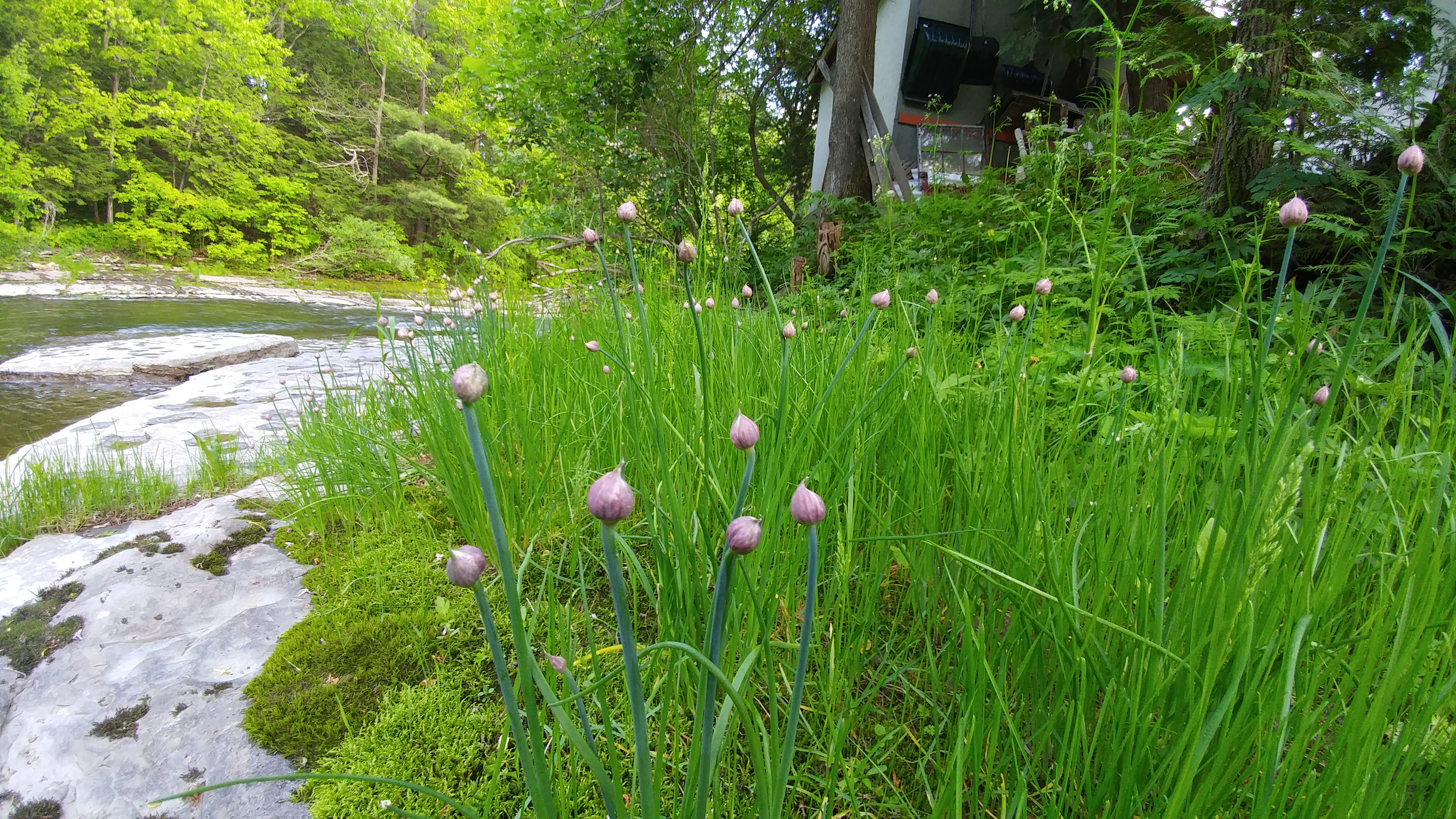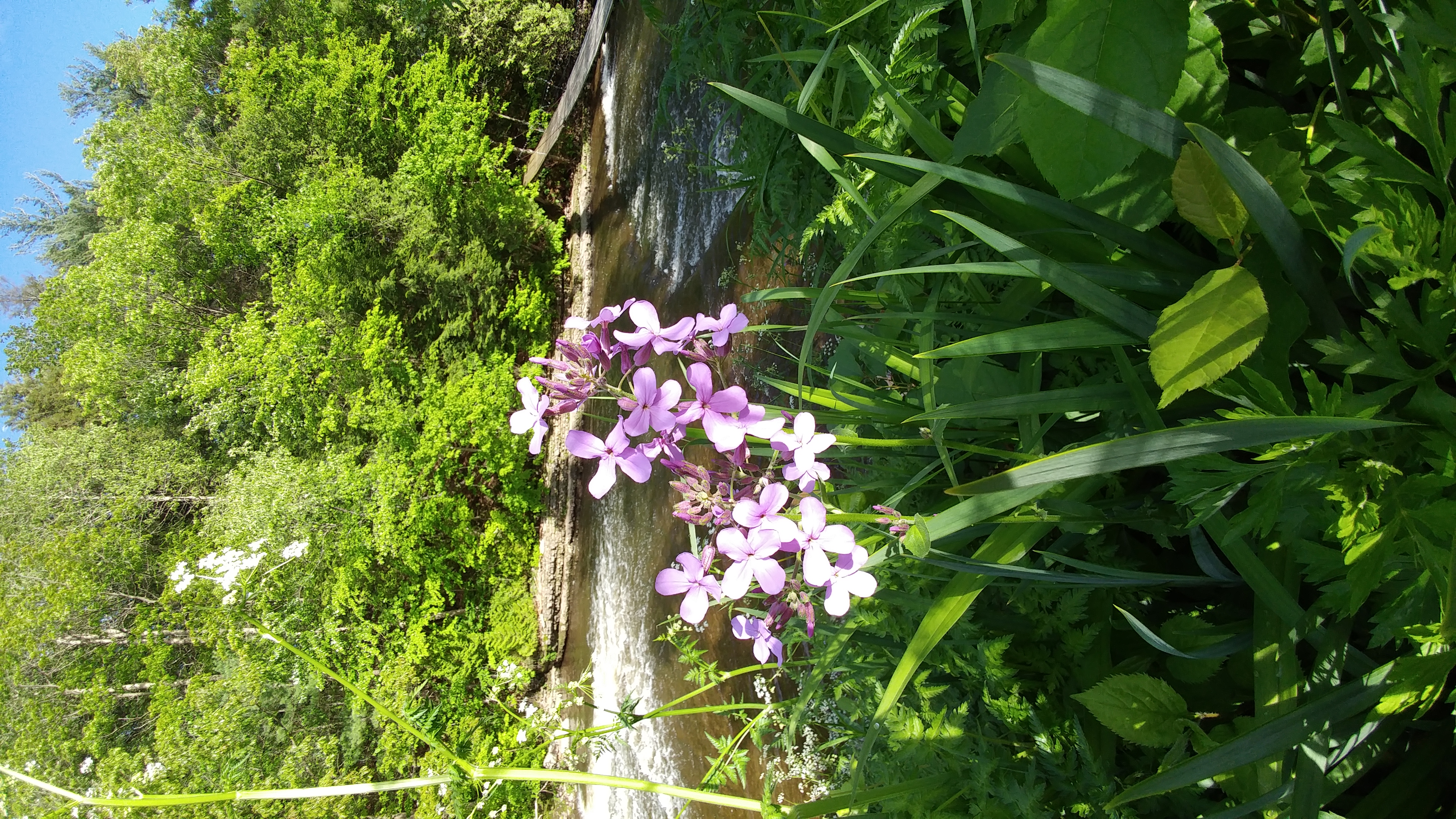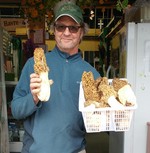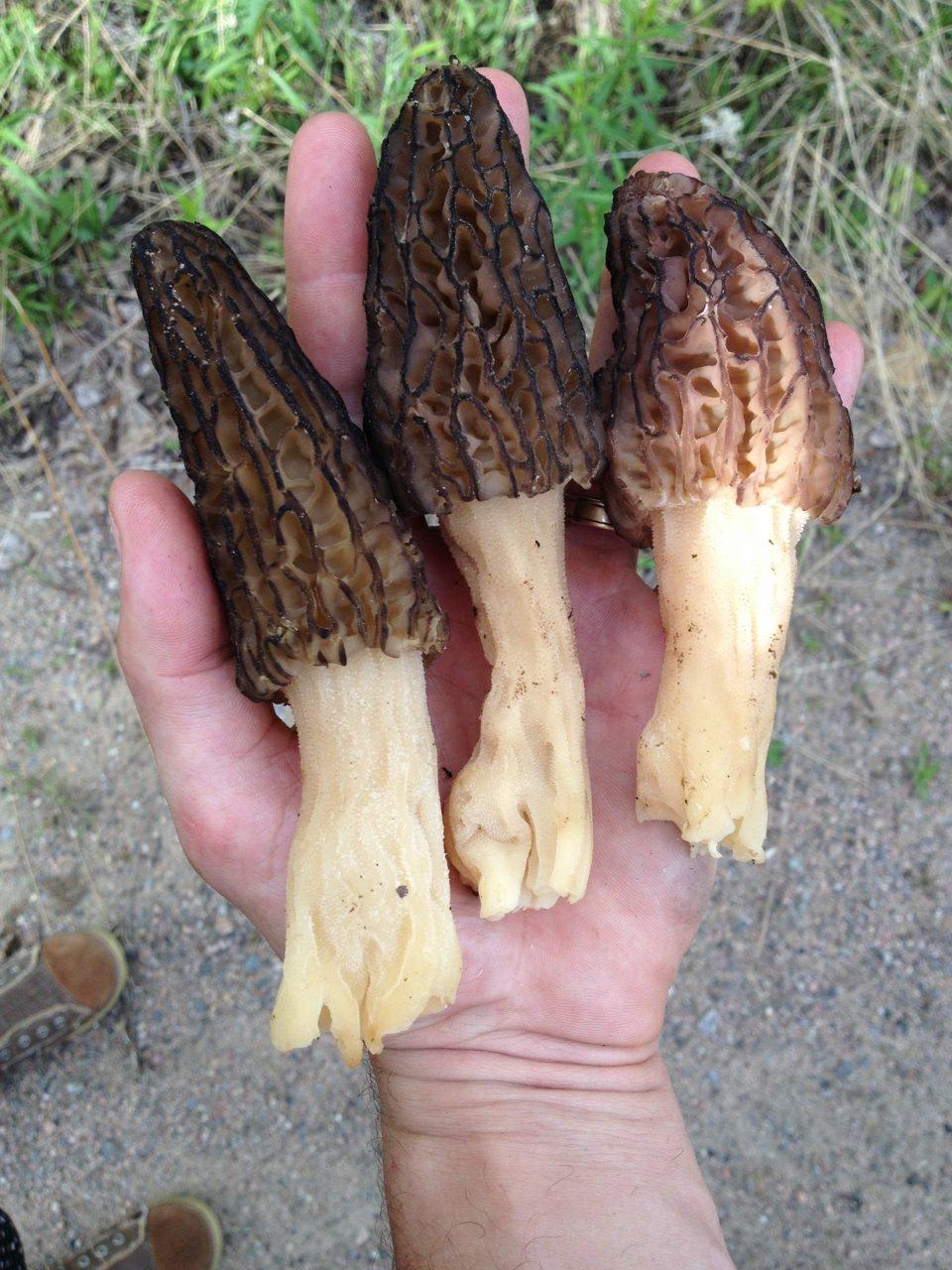Entries in wild food (5)
Jardins Sauvages News and Schedule for 2018: Valentine's menu, Pop-ups, Workshops and more..
Bonjour, (an English message will follow..)
Notre menu St-Valentin, ‘Sauvage et Aphrodisiaque’ est disponible samedi le 10 et 17 février à 19h; sur réservation seulement; vous pouvez venir en couple ou en groupe.
C’est un menu dégustation cinq services (entrée, soupe, salade composée, plat et dessert); Apportez votre vin, bière ou porto.
120$ par personne tout inclus. 150$ pour La Totale, Menu Deluxe (menu 7 services avec foie gras et fromage)*
120$ (90.75+ 15% pb 13.61 + 5.22TPS+ 10.41TVQ); 150$ (113.45 + 15% pb 17.02 + 6.52TPS +13.02 TVQ)
Payable en argent comptant ou par chèque le soir même, ou par carte de crédit au téléphone lors de la réservation.
Vous pouvez consulter le menu ici : http://www.jardinssauvages.com/?nom=menus&m=mval18
Pour réserver, SVP appelez au 450-588-5125.
Je vous invite à visiter notre site pour l’horaire de nos activités pour l’année 2018, incluant le calendrier de dates pour les menus ‘pop-ups’ saisonnier (quand vous pouvez venir 2 ou 4 sans accompagner un groupe) et notre fameux menu champignon..) En dehors de ces dates, le resto ouvrira que pour des groupes de 6 et plus. Le menu thématique suivra les saisons comme toujours avec plantes et champignons sauvages à la une, gibier et produits du terroir, toujours affiché sur le site à l’avance.
On va continuer la visite libre le dimanche après-midi cet été.
*Le prix du menu est maintenant ajusté ‘tout compris’ (incluant taxes et service), nous n’avons pas monté nos prix! Ça fait longtemps que nous voulions adopter cette formule mais nous hésitions à la faire parce que ça paraît plus cher et qu’on paie tous plus de taxes (sur ce qui aurait été pourboire). Par contre, c’est juste plus logique et plus simple pour tous. C'est aussi important par principe (impliquant le partage des pourboires/équité salariale). Nos serveurs sont payés un salaire régulier comme tous les employées, selon compétence et expérience inclus dans le prix.
Ateliers et Stages au printemps
Autre nouveauté, ce printemps, il y aura une série d’ateliers le dimanche après-midi, ouvert au publique sur les plantes sauvages et champignons sauvages de la cueillette à la cuisine (sur réservation avec dépôt). http://www.jardinssauvages.com/?nom=une
Et des jours de stage les lundi matins en mai (ou les gens peuvent s’inscrire pour apprendre en travaillant, cueillir avec/pour François (places limitées).. Liens
Avez vous gouté à nos soupes et plats cuisinés ‘prêt à manger’?
Notre kiosque au marché Jean Talon est ouvert 7 jours : où nous avons notre gamme de légumes et champignons sauvages du Québec congelés, plats cuisinés et conserves, notre grande variété de produits transformés ‘local et sauvage’ – vinaigrettes, moutardes, épices, aromates et thés.. Nouveautés : confiture aux fraises des champs, ketchup chicoutai, notre menu de tisanes et notre soda sumac-érable (sans sucre rajouté).. http://www.jardinssauvages.com/?nom=produits
L’Actualité
Un petite article dans la revue l’Actualité qui nous mentionne : http://lactualite.com/art-de-vivre/2017/12/08/la-foret-dans-lassiette/
Au plaisir,
François et Nancy
Vous pouvez aimer notre page facebook aussi pour avoir les nouvelles et menus à jour.
Twitter/Instagram : @soupnancy #LesJardinsSauvages
Merci
Greetings,
Our Valentine’s Day Menu is Wild & Aphrodisiac and available two Saturday nights at 7pm the 10th and 17th of February,
The menu: http://www.jardinssauvages.com/?nom=menue&res=m&m=val18en
It’s a five course meal (entrée, soup, composed salad, main, dessert) for 120$ all included* or the Delux Menu 150$* for 7 courses with foie gras and cheese.
(120$ (90.75+ 15% tp 13.61 + 5.22TPS+ 10.41TVQ); 150$ (113.45 + 15% tp 17.02 + 6.52TPS +13.02 TVQ))
Bring your own wine, beer or porto.
On reservation only.
Payment is by cash or cheque on spot, or by credit card by phone in advance/upon reserving.
We are 45 minutes NE of Montreal on Route 341 (15 minutes from the 40). For more information, you can visit the website www.jardinssauvages.com or call the restaurant.
To reserve, please telephone 450-588-5125.
*You will notice that the menu price is now adjusted to be ‘all included’ (tax and service), so no tipping necessary and no, we haven’t upped our price. This formula makes more sense all-round, being more logical and simple for everyone, not to mention on principle (implying tip-sharing for more equitable pay structure). The waiters are paid a salary based on their job description, competence and experience, like all employees, that is included in the ticket price. We have long wanted to adopt this but held back due to ‘sticker shock’ and fact that more of the bill goes to taxes (on what would have been tip), and this remains frustrating/a challenge. We hope our customers will understand and appreciate the change, figuring that most people were tipping more than this 15% before tax.
Our schedule for the season is up on the home page of the website, starting with the maple menu in April and including all dates for our seasonal pop-up events, as well as the famous fall mushroom event.. Beyond these set calendar dates when you can come 2 or 4 people without a group, the restaurant will only open for groups of 6 or more.
We will continue our open visit on Sunday afternoons this summer.
This spring, there will be a series of workshops on foraging and cooking wild foods on Sunday afternoons (on reservation with deposit).
As well as the possibility of ‘stage’ Mondays in May where people can sign up to pick with François, learn while working.. http://www.jardinssauvages.com/?nom=une
Have you tasted our soups and ready-to-eat cooked dishes?
We invite you to visit our stall Jean Talon Market open seven days: On offer alongside a few local cultivars are our wild and local mushrooms and vegetables that are frozen, vacuum packed and ready to eat as well as our soups and sauces, cooked dishes and long line of preserves. Beyond dried mushrooms and teas, herbs and spices, mustards vinaigrettes and pickles.. Novelties: wild strawberry jam, cloudberry ketchup, sumac maple soda (with no added sugar).. http://www.jardinssauvages.com/?nom=produits
L’Actualité magazine – An article in the current L’Actualité on wild herbs that features us. http://lactualite.com/art-de-vivre/2017/12/08/la-foret-dans-lassiette/
Enjoy the winter!
Hope to see you soon,
Nancy and François
La Table des Jardins Sauvages
17 Chemin Martin, St.Roch de L’Achigan
450-588-5125
You can always like our Facebook page to follow our news and up to date menus.
Twitter/Instagram @soupnancy #LesJardinsSauvages
Thank you.
François' tomatoes, and a few summer recipes
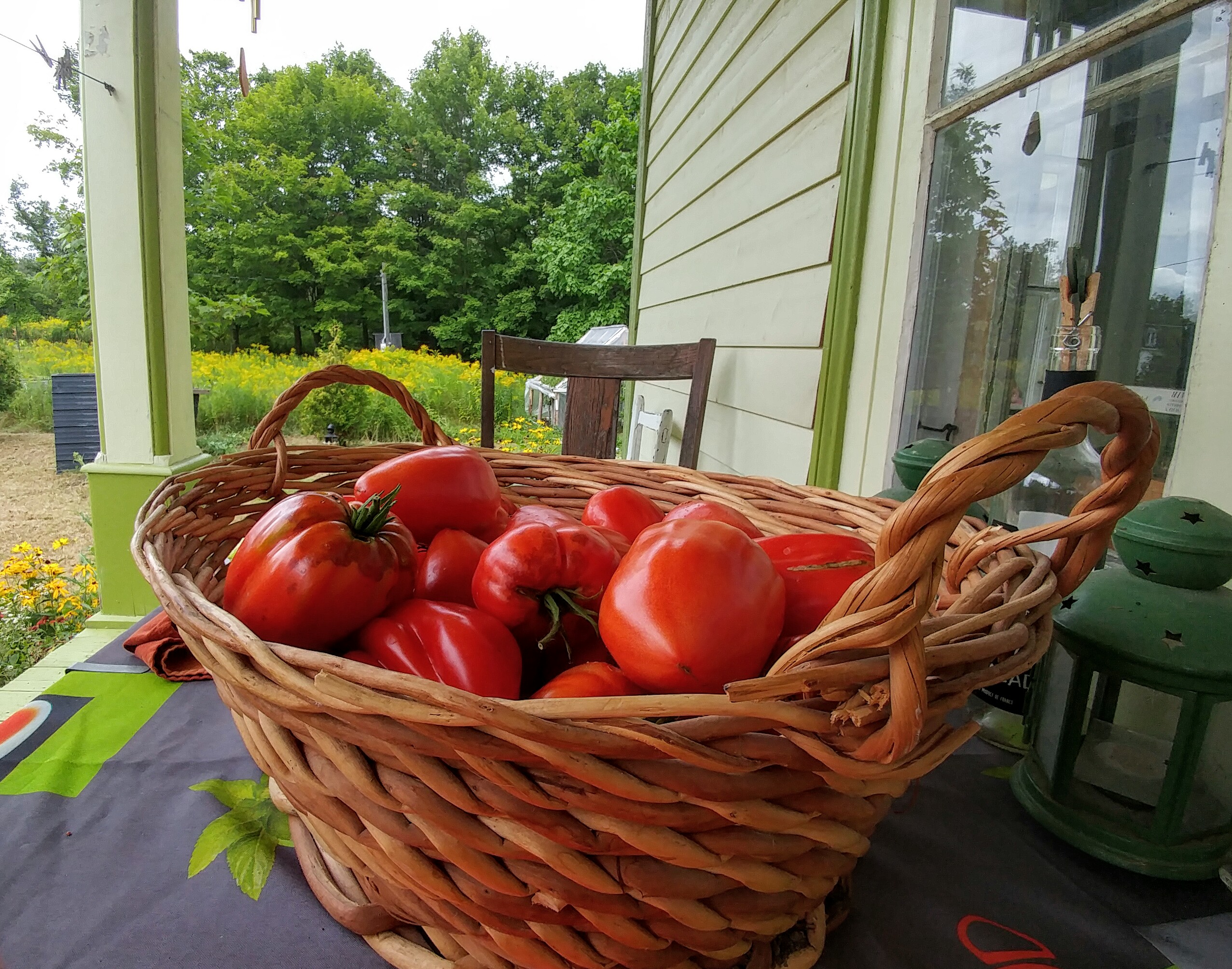 We may as well talk about tomatoes since there isn’t much going on in terms of local mushrooms. What a crappy season so far. I mean we’ve had a few good harvests but we are not meeting the demand at the market, and with a trickle for the restaurant menu, I haven’t started putting up. When you consider that I typically process 2 tons of mushrooms for our year (to supply the restaurant and make our products), I will have to get started soon enough.. Pretty frightening. Fingers crossed.
We may as well talk about tomatoes since there isn’t much going on in terms of local mushrooms. What a crappy season so far. I mean we’ve had a few good harvests but we are not meeting the demand at the market, and with a trickle for the restaurant menu, I haven’t started putting up. When you consider that I typically process 2 tons of mushrooms for our year (to supply the restaurant and make our products), I will have to get started soon enough.. Pretty frightening. Fingers crossed. 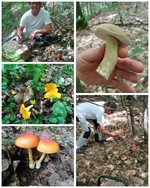
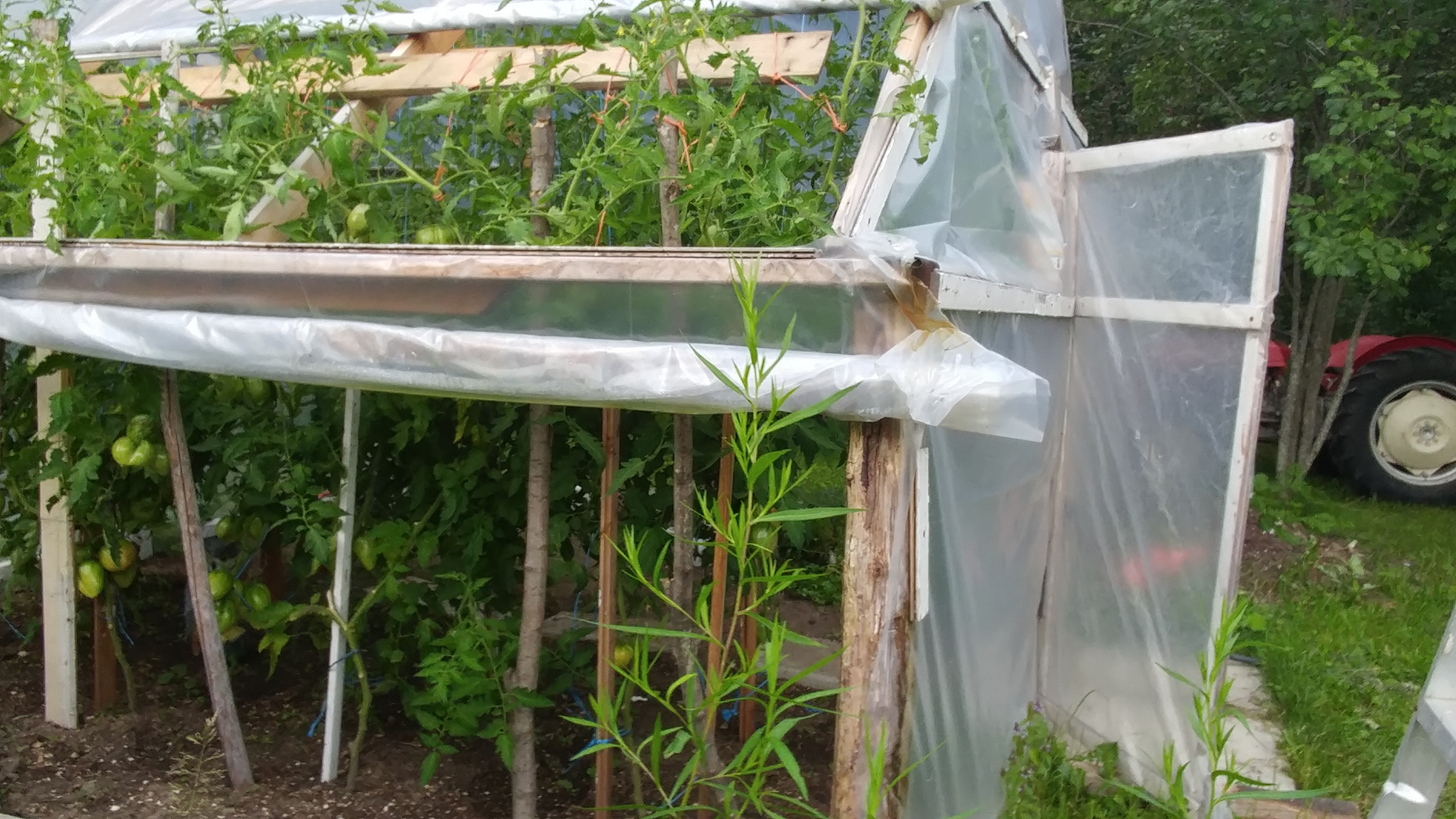
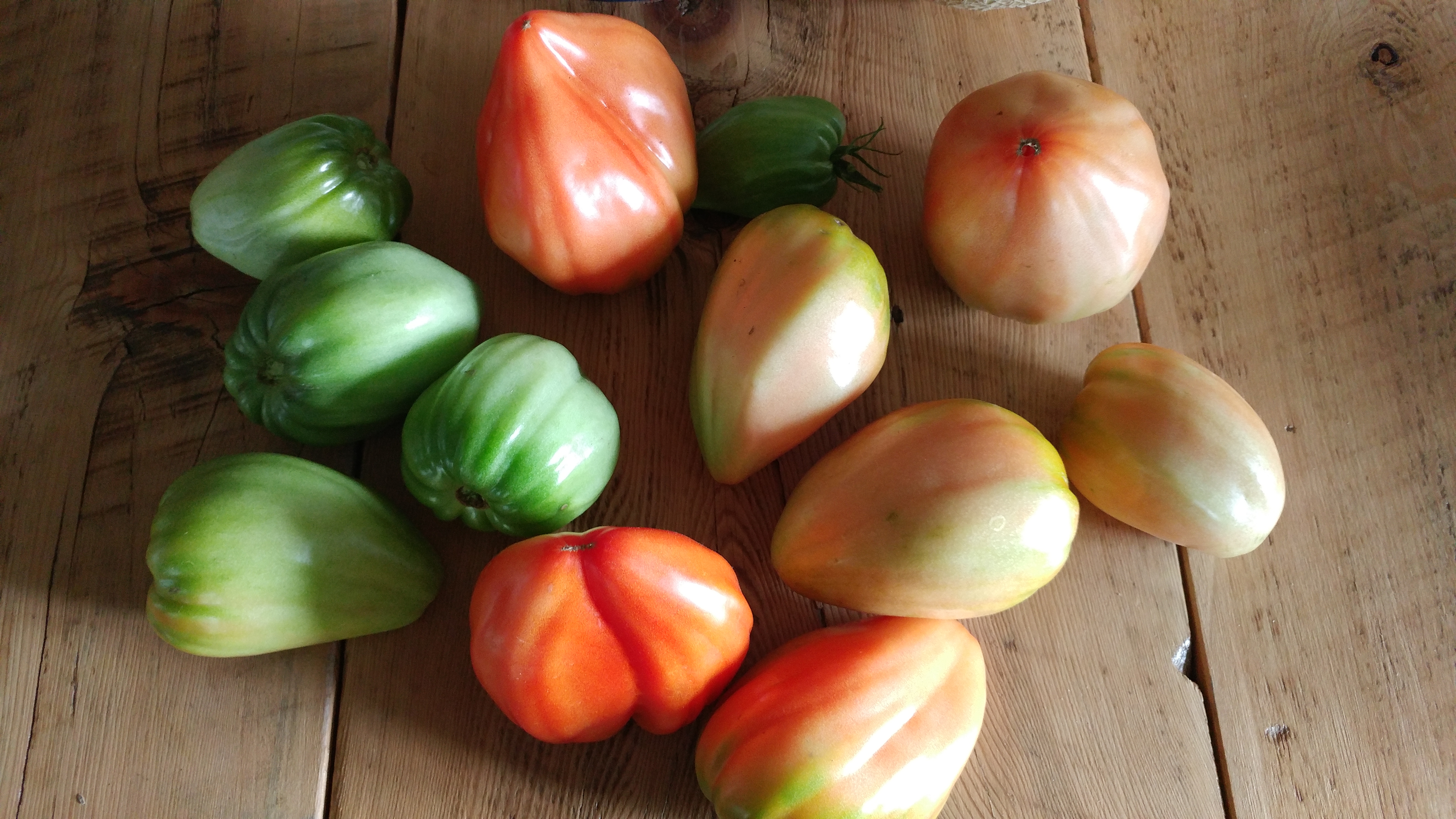
So anyway, back to the tomatoes. Anyone who knows us (or follows me) has heard of François’ famous tomatoes. They are an old heirloom variety whose name eludes us, from seeds passed down generations in Pasquale’s, (one of his Italian mushroom pickers) family. His great grandfather brought them over here like a century ago. François kept the seeds from the tastiest of his specimens and started them this winter, moving them into a greenhouse in the spring, and he lovingly tends to them every day with water and suckering, tying them up (they are 9ft tall!) and etc. He has planted some in the garden too and distributed seeds to other gardeners as well, in hopes to keep the variety alive.
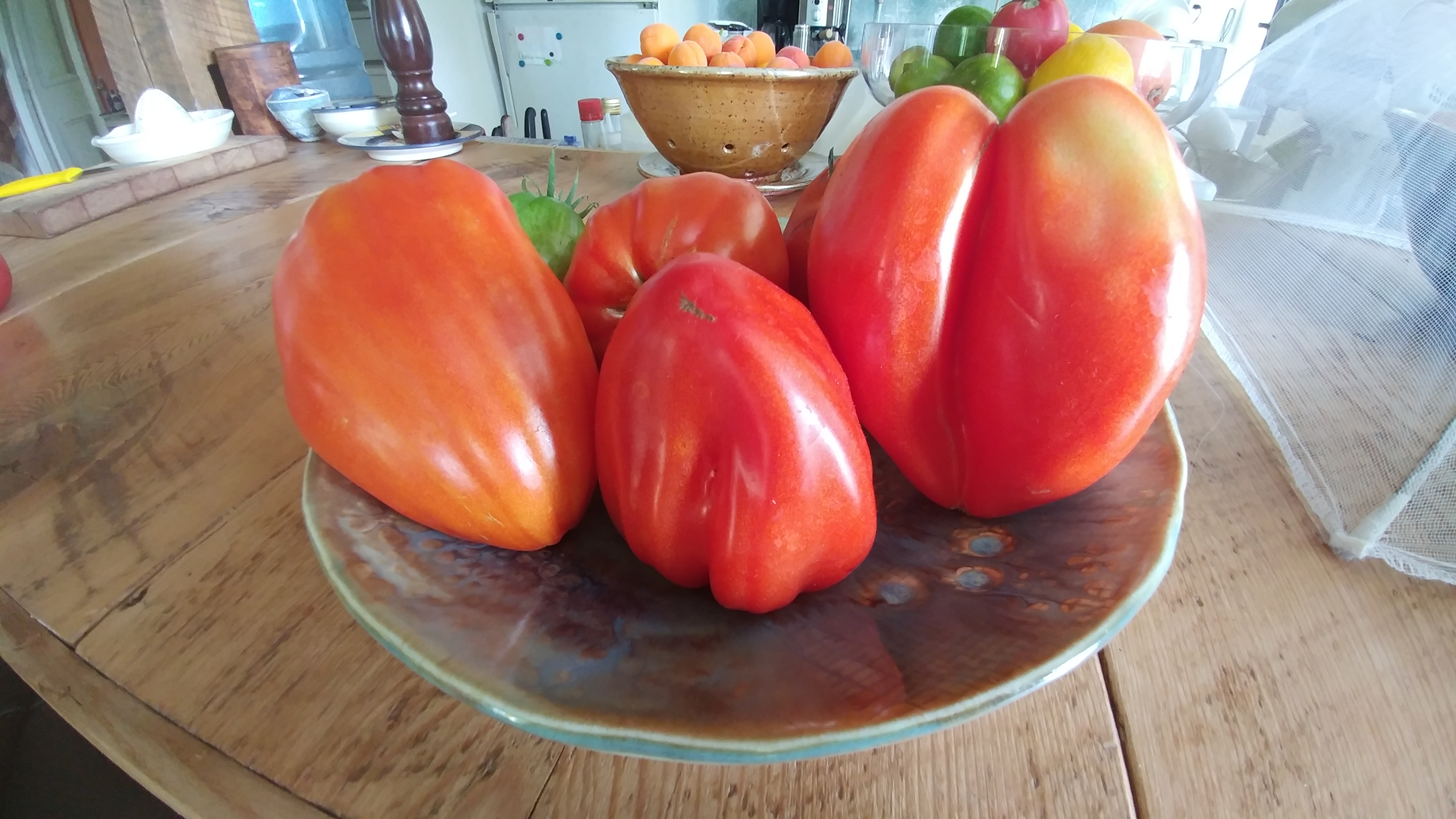
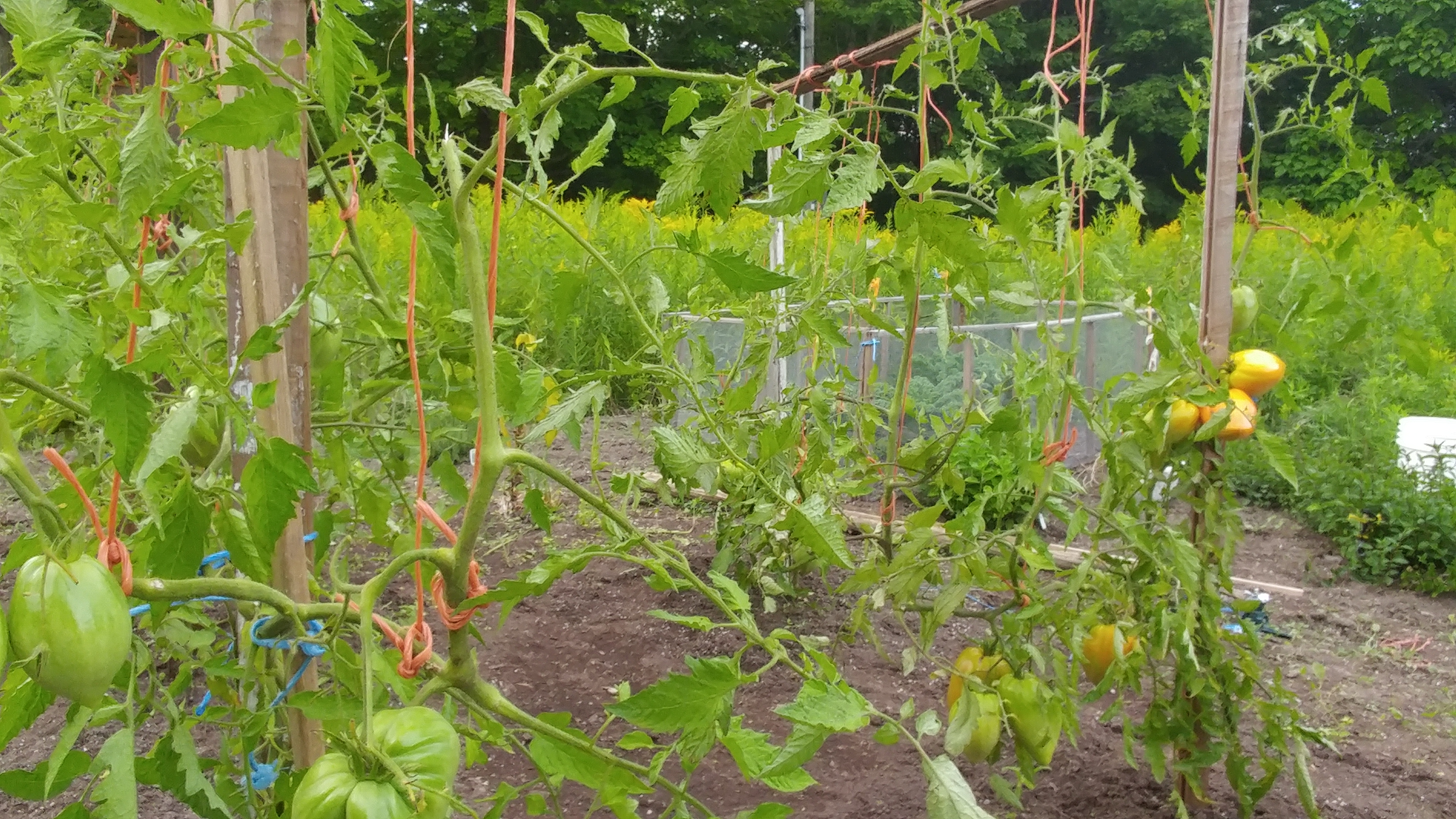
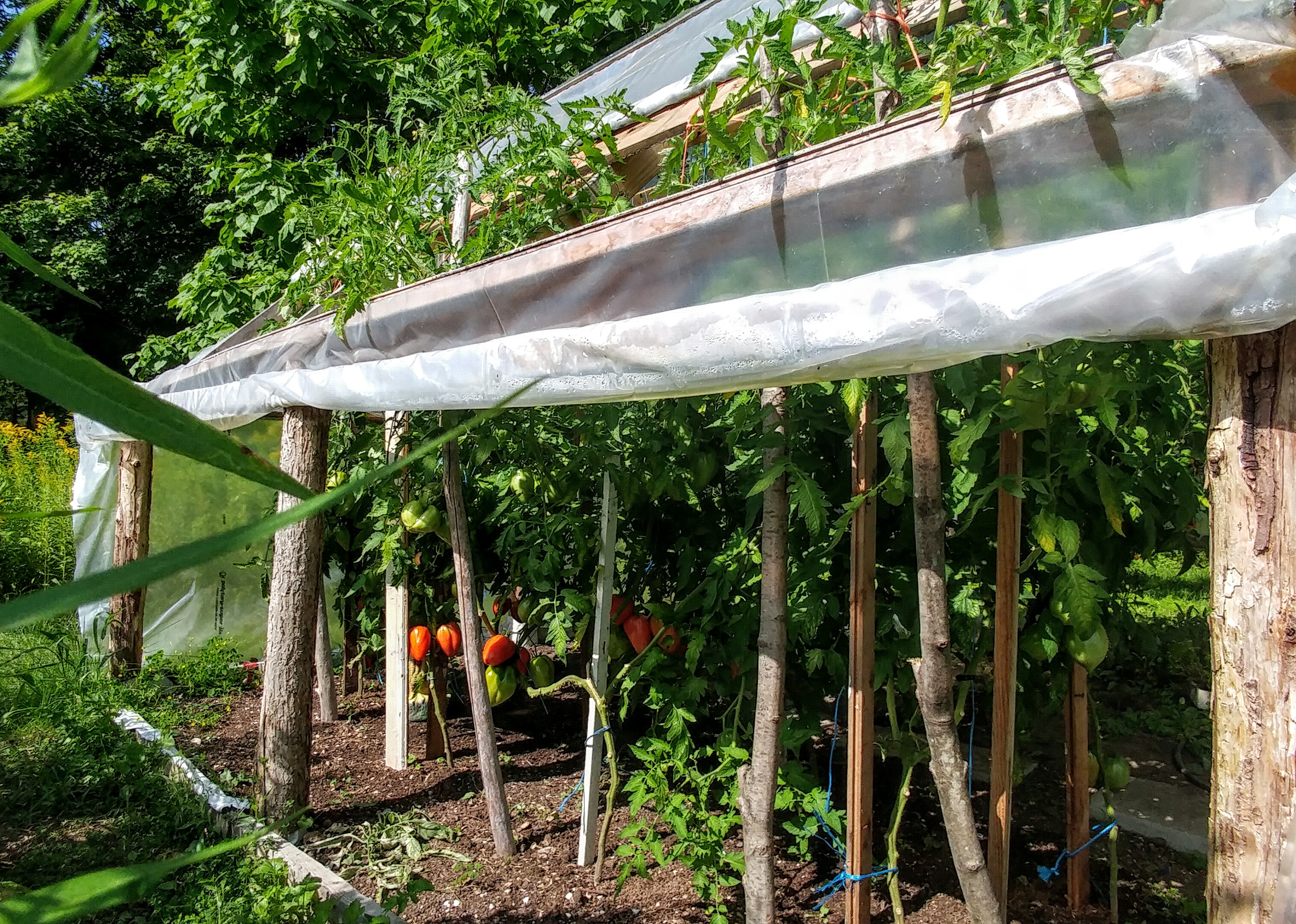 Greenhouse vs field, the taste test is on..
Greenhouse vs field, the taste test is on..
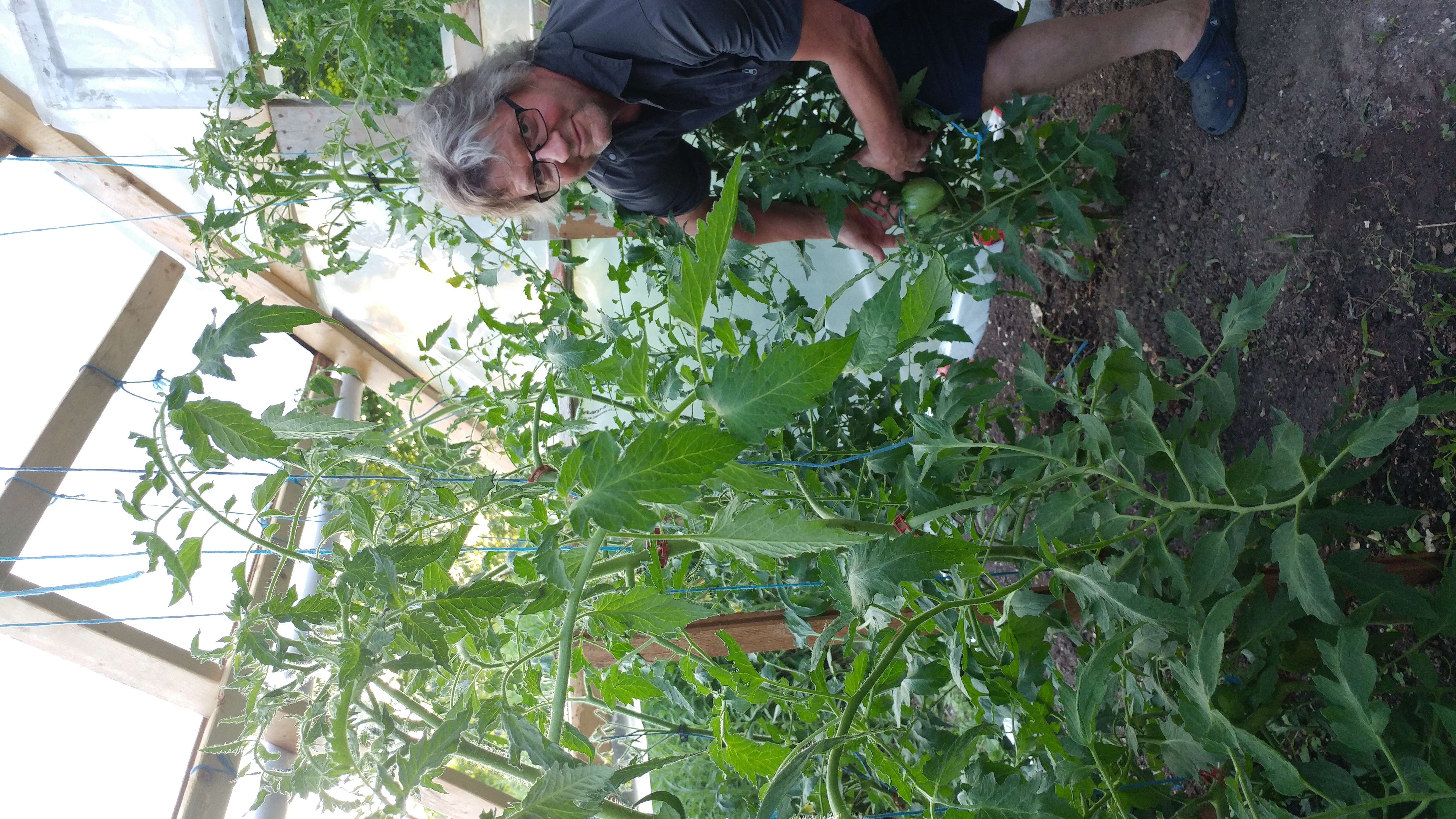 Proud green thumb
Proud green thumb
I can’t tell you how important his tomatoes are to him, and hence what an exciting time it is in our household now that they are finally becoming ready. He lays them out on the counter in order that they will be eaten and for different uses.. Woe and behold if I take too many to the restaurant or if I chop up the one that was meant for a sandwich, or yikes, slice it ‘the wrong’ way - Watch out for the St-Roch tomato police!
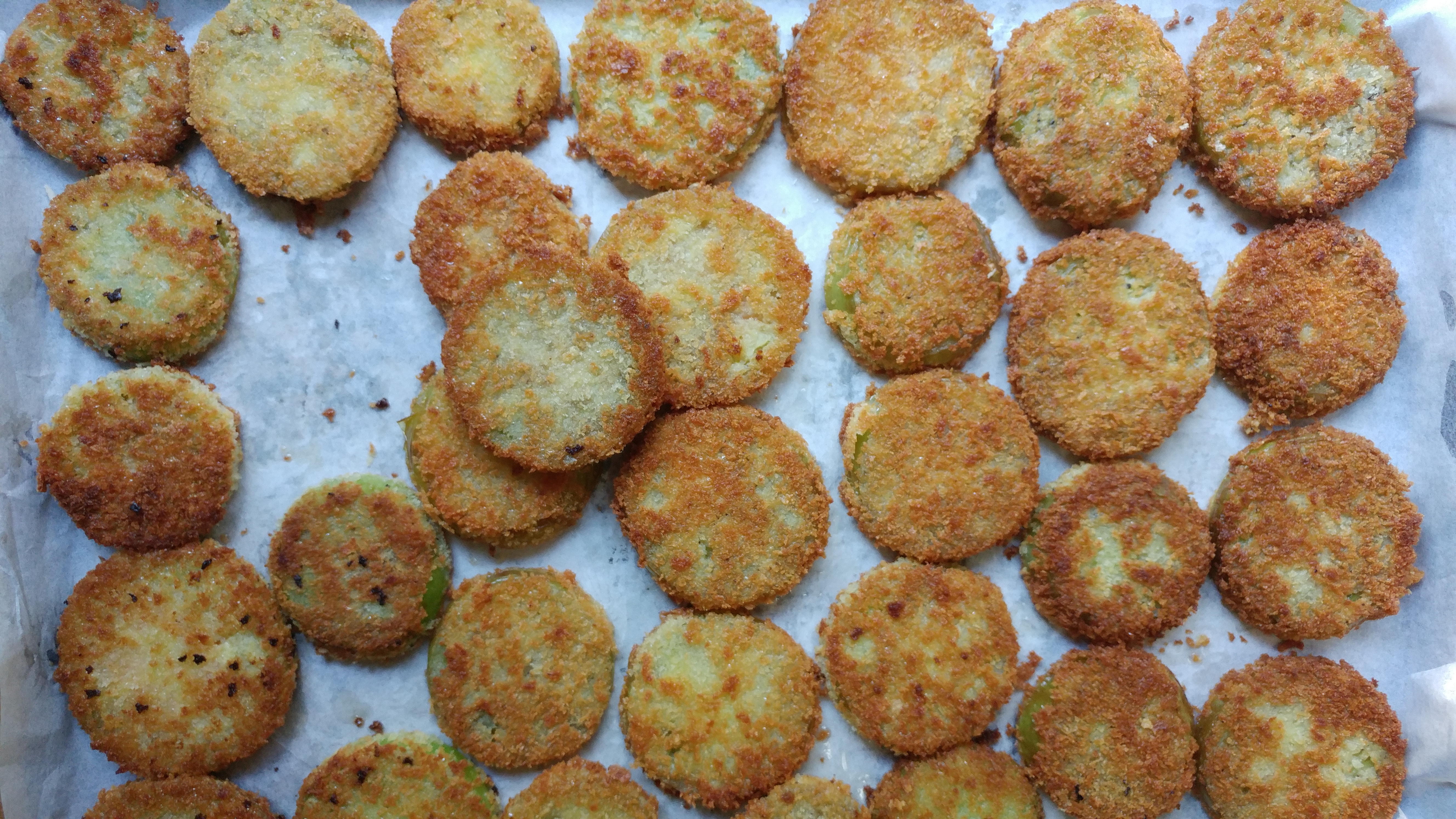
The first dish was of course Fried Green Tomatoes, which has become an annual ritual since we started making them (http://soupnancy.squarespace.com/blog-journalessays/2009/10/7/fried-green-tomatoes-finally.html), François just adores them. And besides, what else are you going to do with green tomatoes. Now that they are ripening, we are eating them in salads and salsa, with pasta and fish. They are meaty, not many seeds buy juicy, sweet and tomatoey, with a bit of tart. I like some acidity but François expects them to be succulent sweet and is banking on the garden ones.
He apparently has tomato tarts and pizza on the agenda, as he has ordered his dough (from me)..
At the restaurant – 1st entree of the moment: Fried green tomato with ripe and smoked tomato, corn, cucumber salsa, sea spinach and sea asparagus, crinkleroot lovage yogurt dressing, smoked eel, bee balm 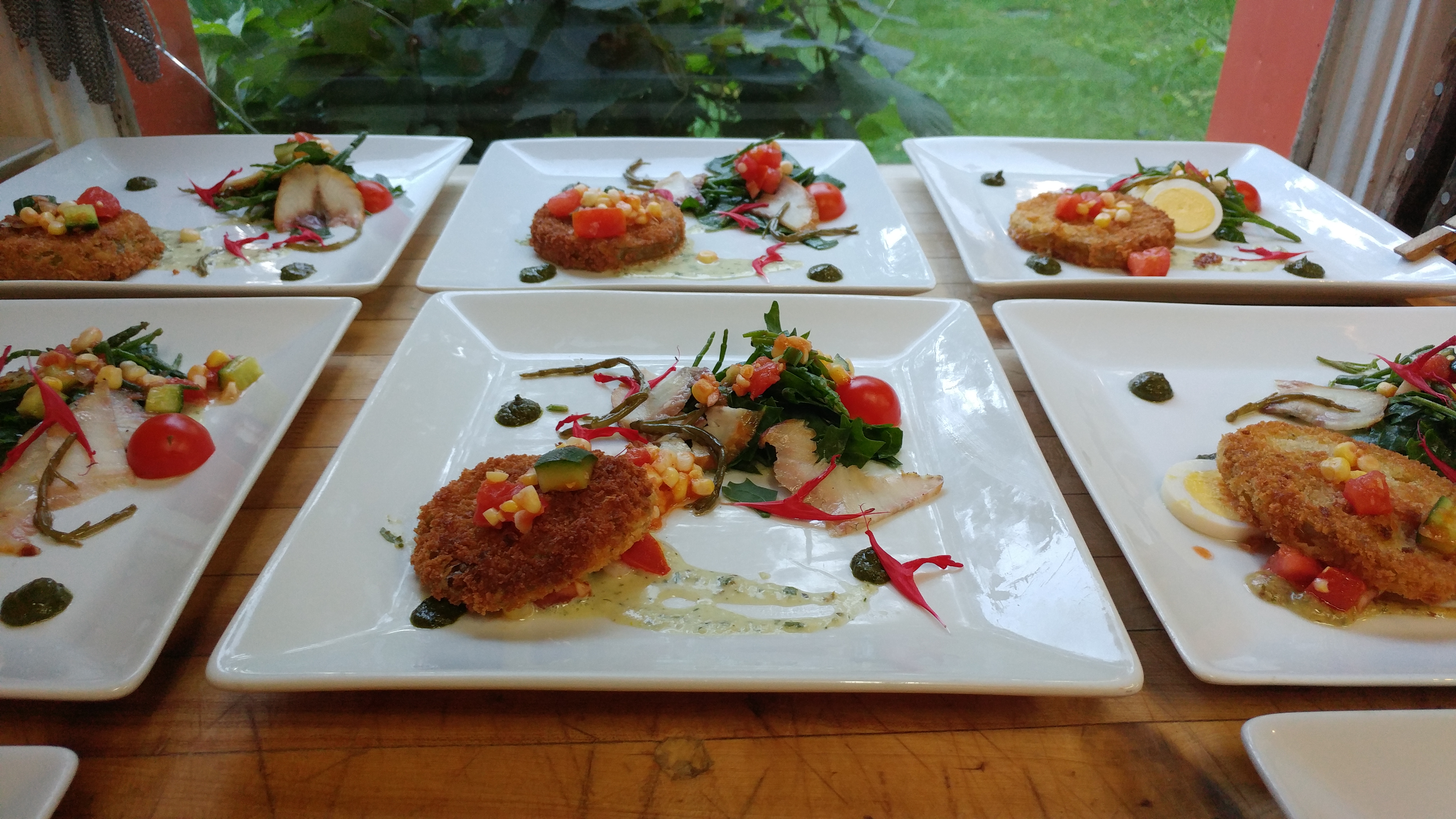
As the harvest really explodes later this summer/fall, I will be canning, smoking, making ratatouille and ketchup, etc..
But it’s not all about tomatoes or even the wild edibles, with the corn and beans, peas, favas, zuchinni and peppers, garlic, kohlrabi.. Lettuces, herbs, Plums, melons and peaches.. Not to mention the wild blueberries! And it will only get better in the month ahead, alongside the mushrooms. September is the best month of the year for food!
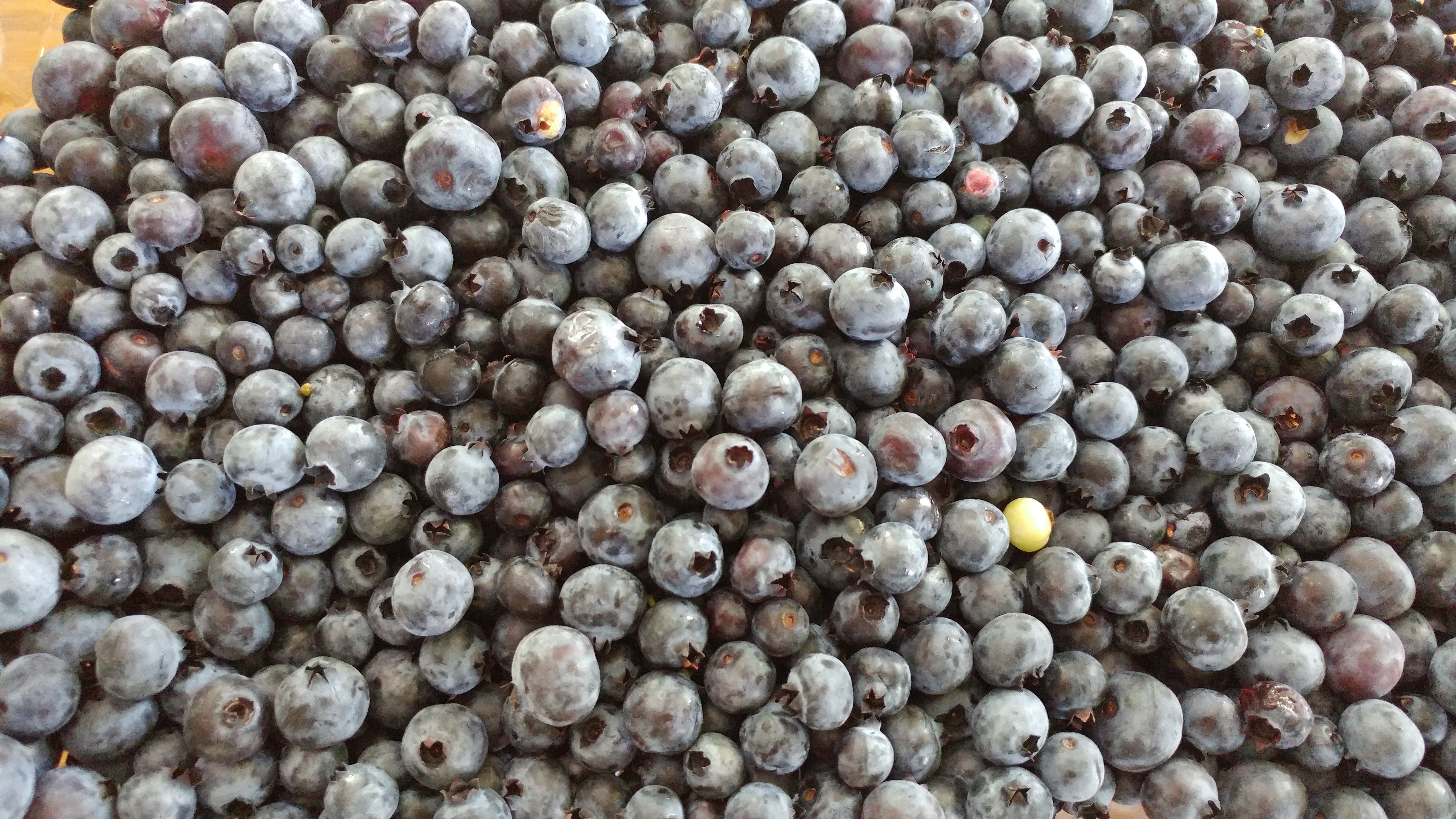
Some other summer hits:
A vegetable stew thickened with bread: ribolita - panzanella meets ratatouille, just a different delicious way to use the garden bounty or what’s hanging out in your fridge. Stew onions with celery/leek, peppers, add zucchini and whatever other veg you like (corn, beans..) Herbs and spices, A bit of white wine and stock or just tomatoes with their juice. At the end, throw in some croutons or dry bread, season and serve on salad with a good oil, aged vinegar and cheese shavings. Good as is or as an accompaniment to sausage, chicken or steak. At the restaurant, I was serving it with confit rabbit. 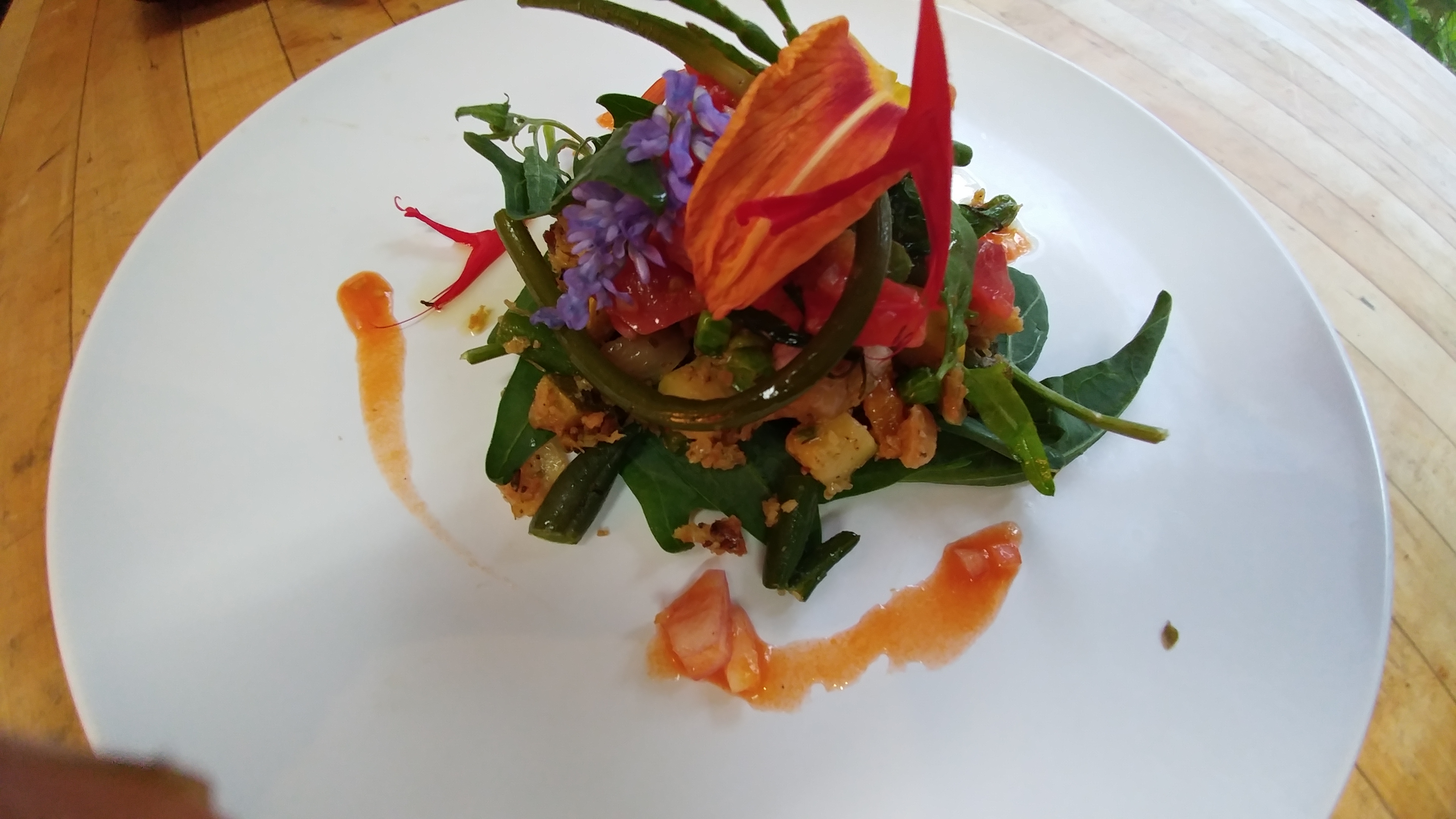
Fleur d’ail (Scapes) as a vegetable and as a condiment
In July when it’s scape time, we put them up for the year, alongside the wild stuff, a raw, green garlicky pesto. But it’s a beautiful time and a 2-3 week window (one for picking one, 2-3 for storing), when you can eat the scape as a vegetable, like an asparagus or green bean. It takes a 5 min. Boil. It is tender when it loses its bright green, sorry. Mildly garlicky, delish. Here the raw pesto is tempered into the hot potato mash, and the cooked scapes are a garnish. Alongside chanterelles which are in season at the same time. Just missing the corn, which would be perfect now. 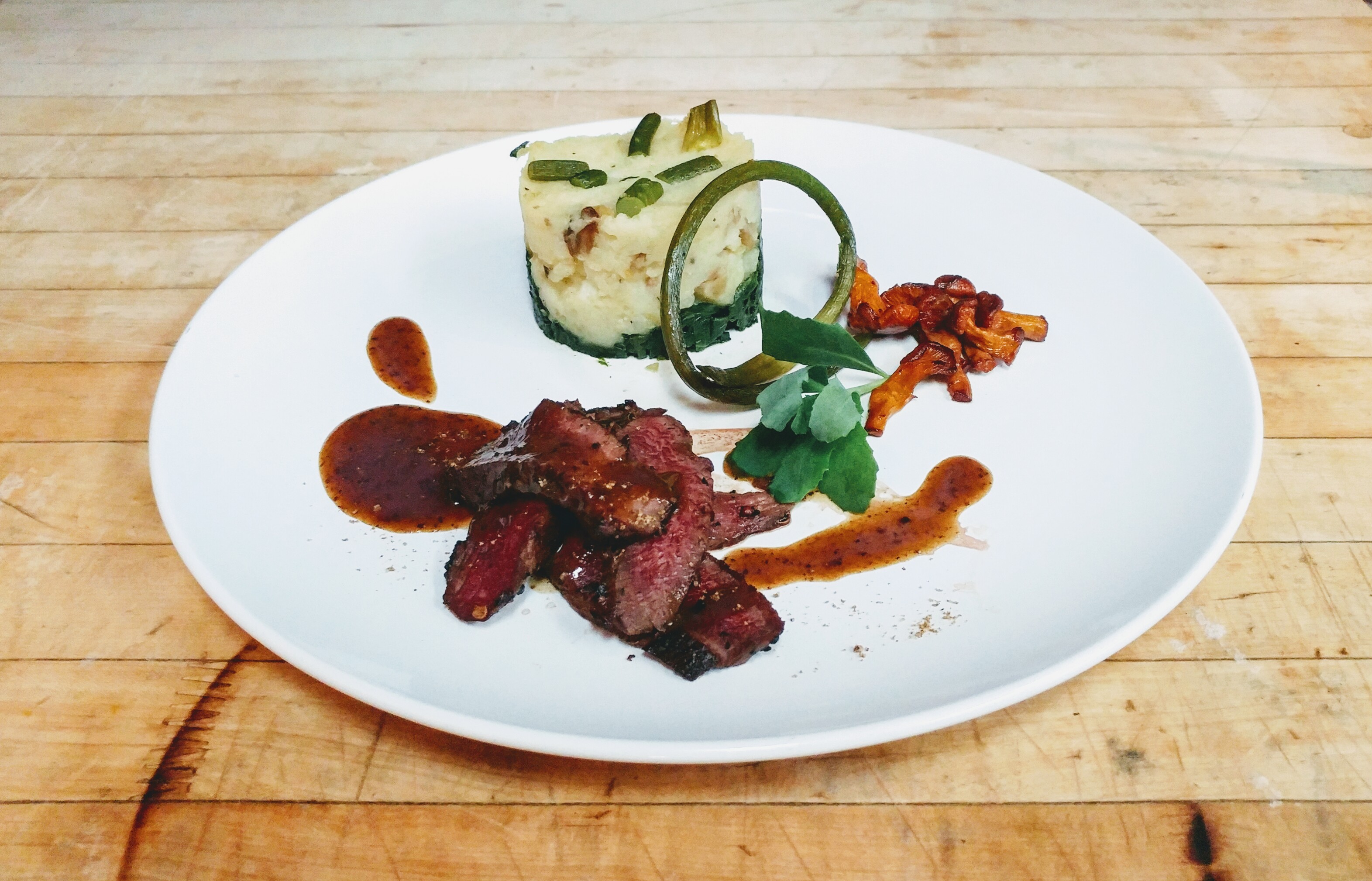
Vichyssoise (Stinging nettle)
Like a Parmentier or any puree/ green soup thickened with potato (so less cream). With stinging nettle and sea parsley, this soup is delicious, but it could be/is with many greens. I make a seasonal green soup with what is abundant, always good. Not only delicious, but nutritious. Served cold on a hot day or hot the rest of the time. Just a basic soup with onion, leek, celery, a touch of wine or vinegar, stock, herbs and spices, potato. Add wild greens. Finish with cream, milk. Tweak with salt, pepper, spice, acid, maple syrup.
Add a little garnish like this: cucumber, radish, lovage, sumac to lighten it up, or it could always be another to make it more hearty like bacon or smoked duck.
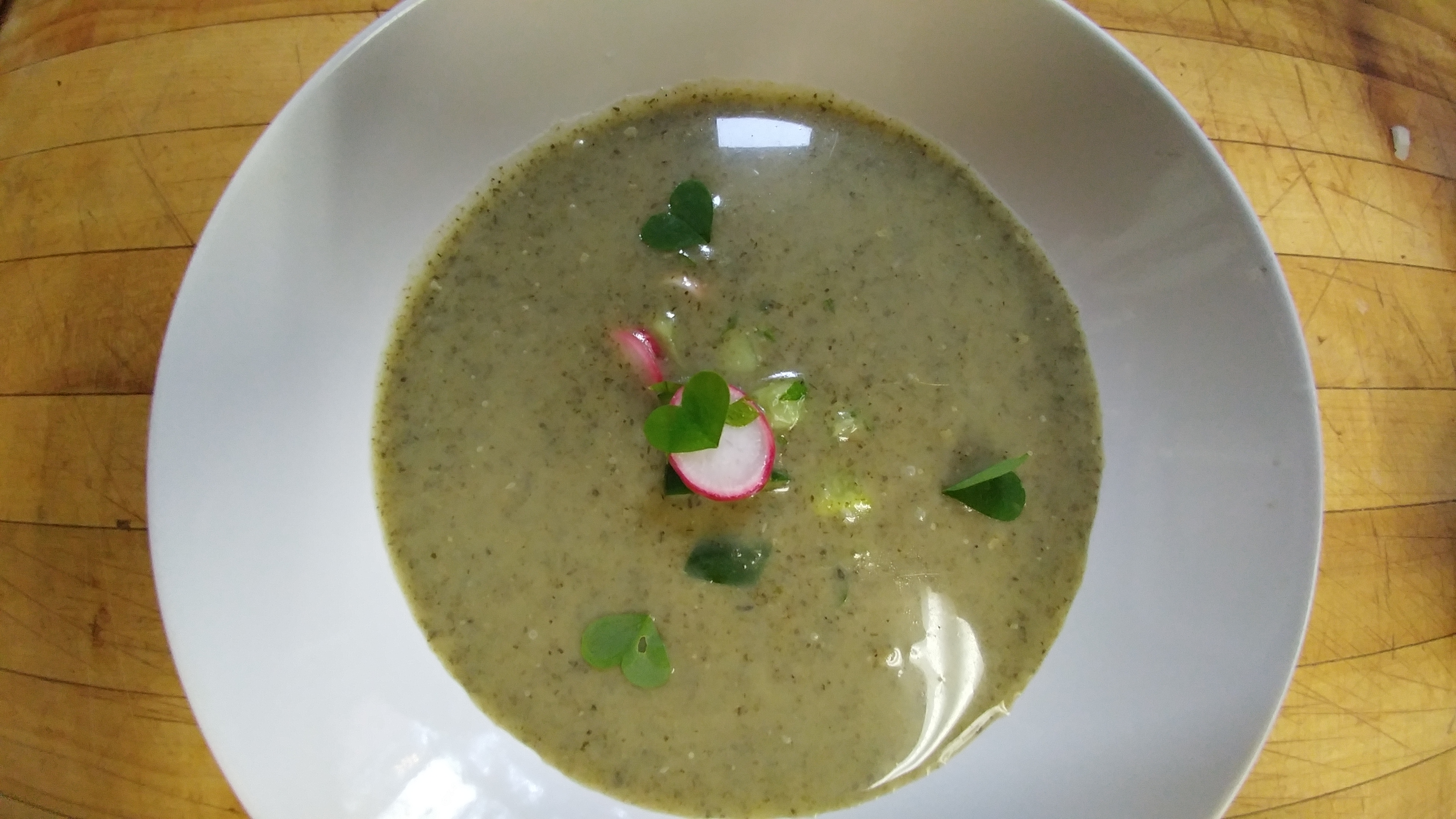
Mushrooms or not, it’s time to be hitting the market (and/or garden) and cooking up a storm!
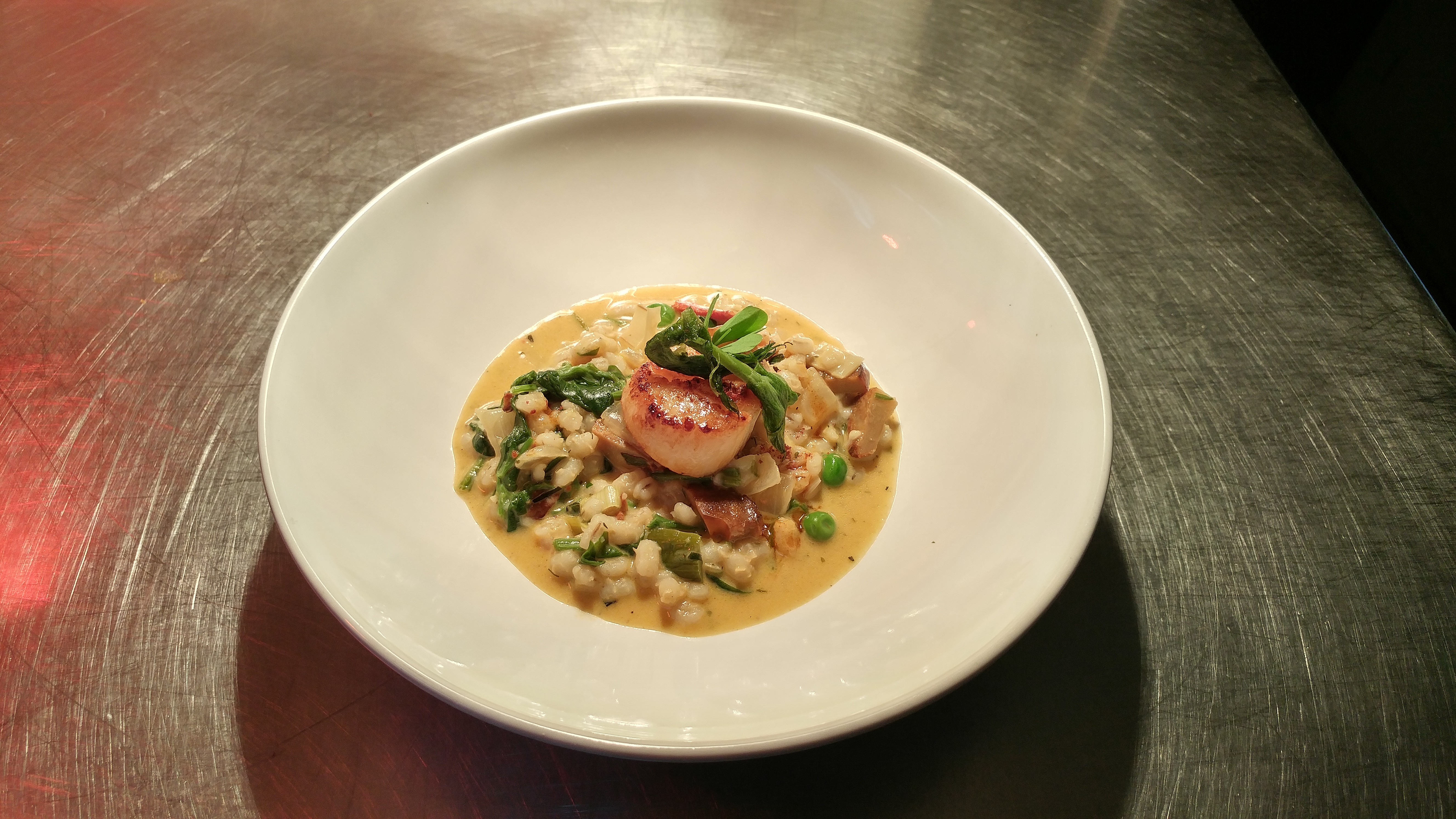 Lobster mushroom and lobster bisque risotto with beach peas, sea spinach and sea scallop
Lobster mushroom and lobster bisque risotto with beach peas, sea spinach and sea scallop 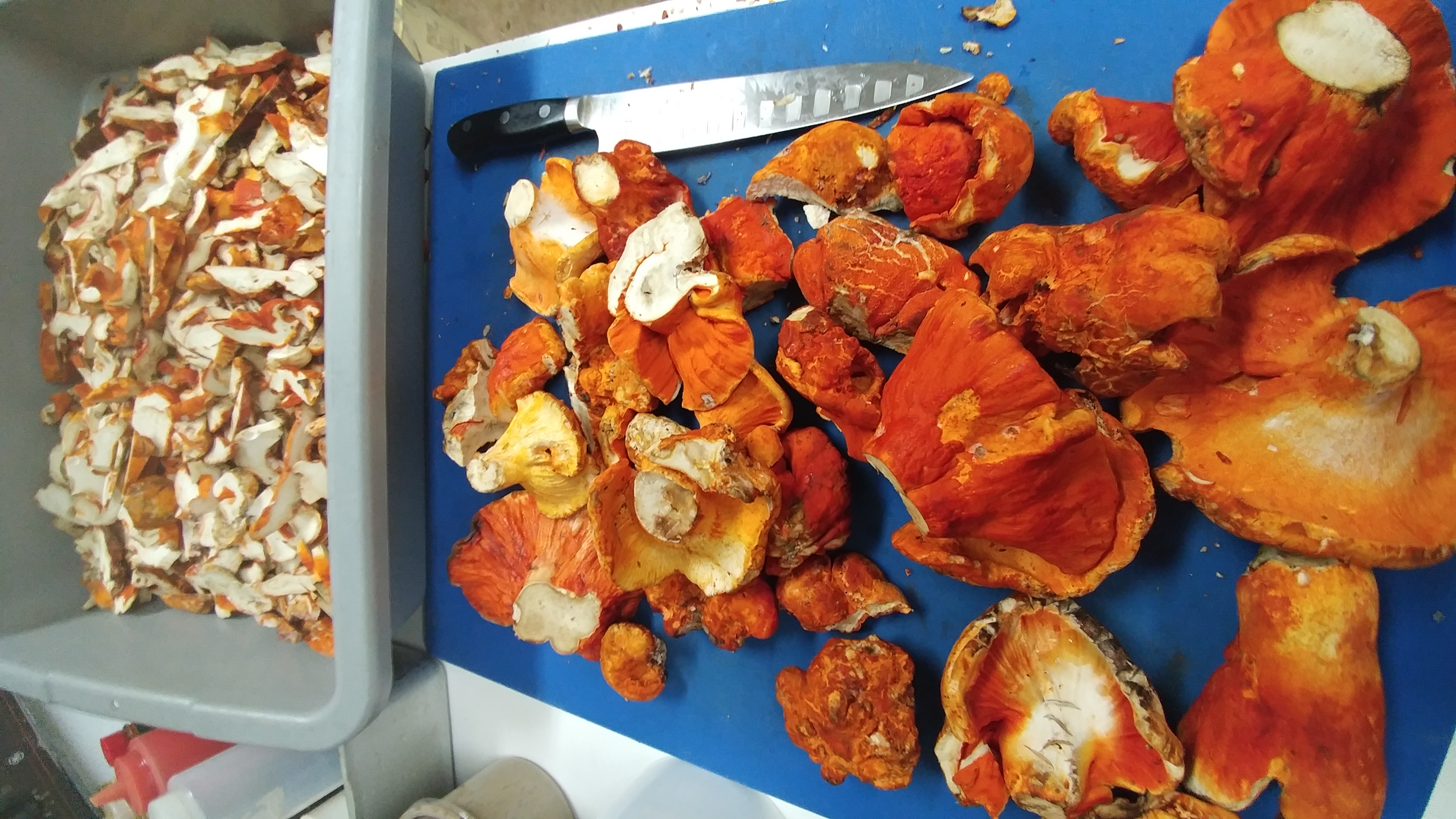 First significant harvest of Lobsters to put up
First significant harvest of Lobsters to put up
Spring meets Summer, Foraging issues and guidelines
Spring meets Summer, finally!
Although it’s still technically spring, it’s starting to feel a lot like summer. A deep, lush green abounds, a symphony of birds chirping, and yup, the mosquitoes are out in full force.
Our spring rush of harvesting shoots and fiddleheads is over. It’s always a mad dash to seize the short window and make the most of it. With a slow, cool spring, the greens were at their best - mild and crisp, delicious.
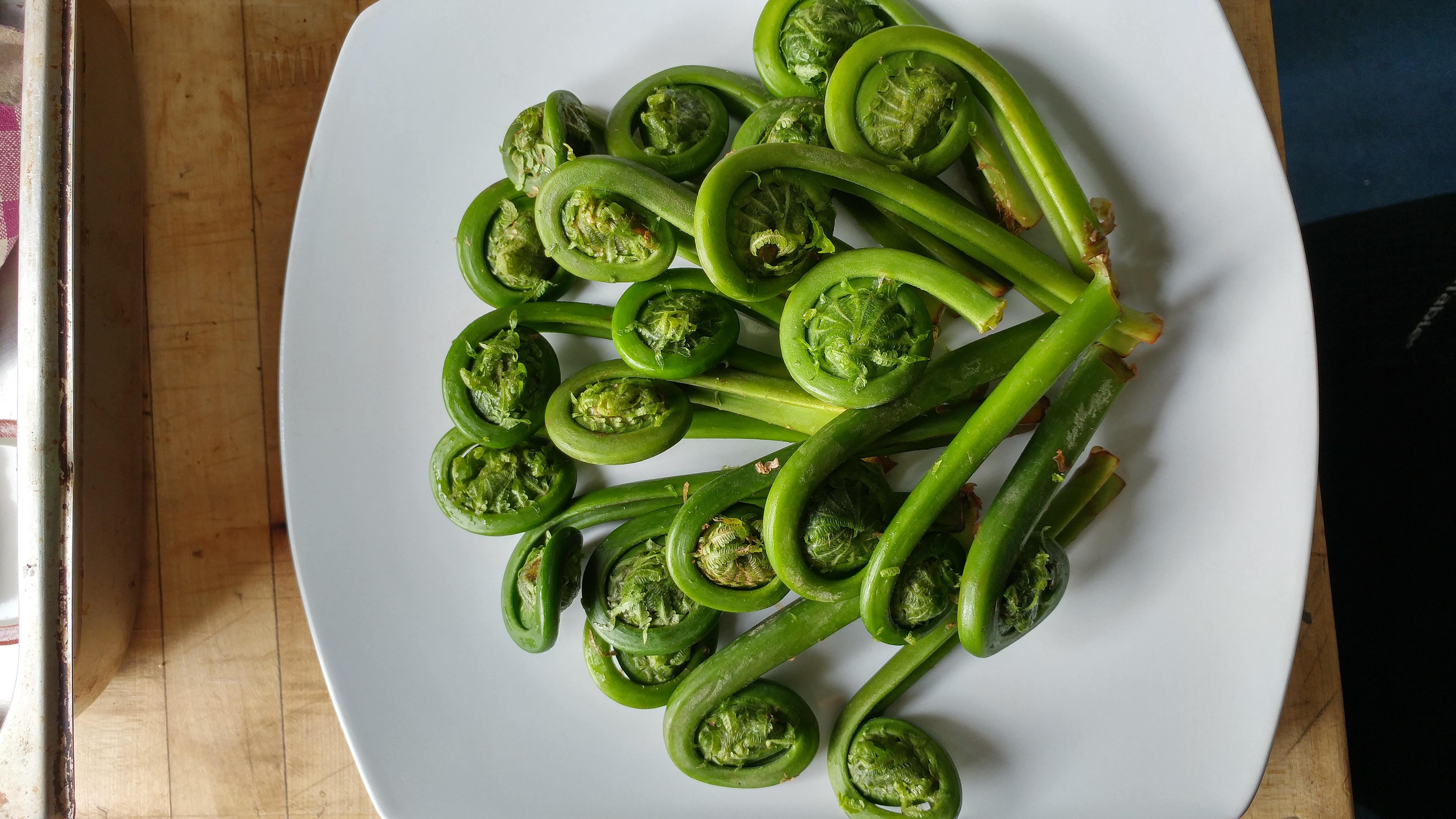 François' 'shade' fiddleheads
François' 'shade' fiddleheads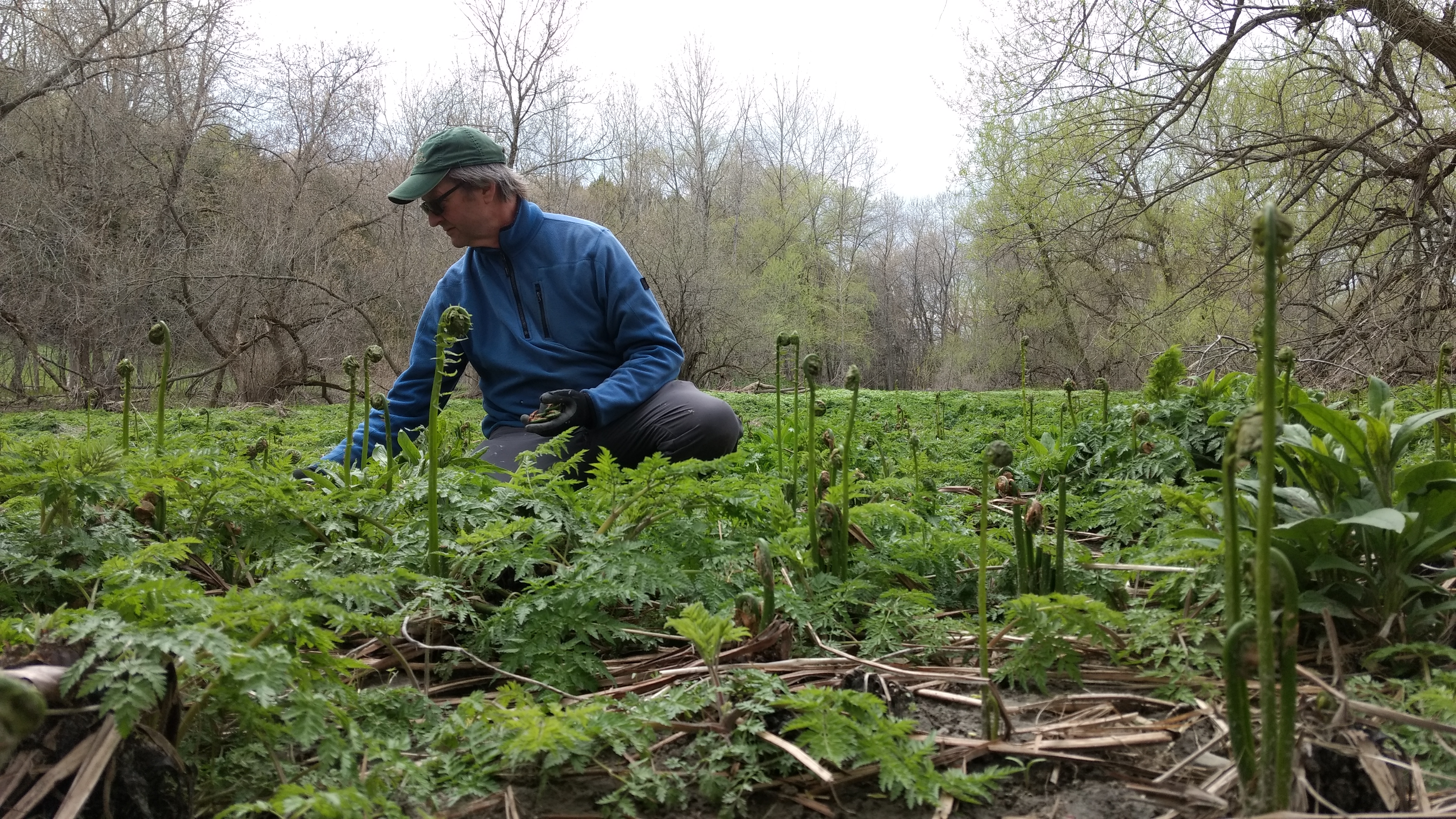
 erythrone/trout lily
erythrone/trout lily
Now, the early season stars like Trout lily, Dandelion, Spring Beauty and Linden have gone, as Stonecrop (live-forever), Daisy and Violet take their place. There is stinging nettle, garlic mustard, sheppard’s purse, wild chives and such.. as the buds appear, the edible flowers start to bloom and first marine greens pop.
It was a great morel season.
I couldn’t help but notice how many people were out there foraging and posting pictures of wild edibles this spring. It is clear that this is a trend that is only growing.
Which is great and NOT.
It’s natural that once awakened to the delights of the forest that passionate eaters and cooks want to get out there themselves. I remember my beginnings at L’Eau à la Bouche with Anne Desjardins where I met François the pioneer of foragers, how thrilling it was to discover these new ingredients. I was lucky to team up and build on his experience, taking the wild thing a step further than the chefs he'd worked with before in the Jardins Sauvages kitchen. But being leaders in largely uncharted territory meant that we had to figure a lot out on our own. Just that a certain plant is edible and best used a certain way is taken for granted now, while many years of research, tests and samples given away lie behind. Not to mention the miles walked and free labour on François' part going back 30 years. Today, it seems that every other menu resembles one of mine from 10 or 15 yrs ago, with game, wild greens & wild flavours everywhere, back when I was the only one with sweet clover or wild mushrooms in my desserts, ha. I knew we were onto something, but who knew it would ‘mushroom’ so.
For sure foraging is awesome in so many ways; it doesn’t get much more terroir, fresh and local than that. But the thing about foraging, is that it’s trickier than it appears! It is not as easy as walking through the woods and filling your basket, it is not 'free'. You need land, and knowledge, a due respect for nature and nuance, lots of time and patience, before actually putting in the hours and doing the work. Finding your spots, being there at the right time, getting down and dirty on your hands and knees with the mosquitoes. It takes more than a day or a season to learn the basics, plenty of books and time spent in the woods. Way more than a google search or utube video, say. People these days want to go too fast. It’s not that I want to discourage eager enthusiasts... But Please! I just wish everyone would be more mindful and cautious. It’s for the plants, the future and one's own sake, not only sustainablility and safety, for deliciousness too.
Foraging primer: Bottom line, Don’t touch unless you know what you’re doing..
Which means How, When and Where.
First of all, know that what you’re picking is indeed edible (there are many look alikes). Ensure that it’s a healthy population. It depends on the microclimate and age of plant population. You need to know the cycle of the plant/how hardy it is before knowing how much you can take. That’s why being in the same spots, seeing the impact of your harvest each year is so important.
Don’t rip out roots (in general). Prune.
If you pick, don’t let it show, as in you’re leaving way more than you take, little trace. Unless you are weeding your garden or in a site with an invasive plant you know well.
Be careful/don’t pick species that are slow to reproduce or endangered: Wild garlic, Wild ginger, Crinkleroot, Milkweed..
And some need to be mature enough, and then just trimmed - like sea asparagus (salicorne, samphire), otherwise you might kill the plant. This is an issue now when it is still several weeks too early to pick salicorne anywhere in Quebec. Yet, I see it on menus.
The ‘weeds’ you can worry less about, Go!: Lamb’s quarters, Nettle, Garlic Mustard, Sheppard’s purse, Purselane, Amaranthe..
And then in the kitchen, they need to be washed, and cooked properly! Some need to be cooked throughout: For instance: Fiddleheads, Milkweed, and most wild mushrooms. Wash well and boil 5min+. Less touchy veg like beach peas, goat's beard, and leafy greens like nettle might only require 1-2min. For mushrooms, a braise is better than a sauté, count 5-20min. Some greens are better raw, but most are better cooked even if slightly. All are super healthy ingredients, but can be toxic, you can’t just wing it. I’ve seen sprouts of toxic plants decorating plates in Montreal.
Don’t give wild plants a bad name by serving anything up because it sounds cool, as little do you know it might be of sketchy quality, often like those on the black market or picked without experience.. For example, dandelion is only good if picked young (before flower) in the morning; most greens like live-forever only in shady, humid conditions; garlic mustard is only yummy young/early season and same, bitter in dry conditions. Same with beech chickweed. Etc. Where, when and how was it picked/stored etc.. is key to whether it will be yummy and not give anyone a belly-ache.
With many wild plants and aromatics (herbs/spices), it’s a question of dosage.. As with nutmeg, basil or rosemary, all of which can kill you if you eat too much. The difference between delicious, medicinal and toxic is in the dose. Normally nature is well made, as in you won’t use anything potent in huge quantities - the difference between a vegetable and an herb, a stock or a sauce. For example, be careful with mélilot/sweet clover flower, sweet grass, conifers - less than .1%. . Oxalis (Lady’s sorrel), like kale and rhubarb leaves contains oxalic acid, which is hard on the kidneys. And so on.
(See more picking tips and photos/links below..)
Whether picking or not, Chefs using wild ingredients need to be responsible for their source or purchases! (See Black Market blurb below) And you can participate. There is a conference on the commerce of PFNL (wild edibles) and the development of guidelines, with chefs and journalists invited (June 14th in Quebec City), the first public meeting of the type, there will be more. It’s about developing the industry further, but in a structured and sustainable way. See below.
Rules and Regulations – they are coming, but it’s complicated
This explosion of amateur foragers and start-ups might be a plus for the economy but problematic for sustainability of the resource and market, quality and safety. Making some sort of regulation has become necessary. Which is what groups of people in the industry and levels of government are currently working on but it’s incredibly complex. Between the interests to develop the forest beyond lumber, putting people to work in the regions, sharing our heritage while balancing what is possible with respect to nature and the realities of the market, labour, what is doable and fair when it comes to enforcement... Quotas, permits?
It’s a big pain in the ass actually. We have no choice but to be implicated, because we care and have expertise to bring to the table, and obviously, it will affect us directly. Trust me, we would rather not have to spend so much time on all this debate and data for regulation because although we believe in it, I can humbly say it shouldn’t even apply to us. Because of all the careless people who ravage or innocently don’t know what they’re doing, we might be banned from picking and exploiting edibles we have plenty of on private property, picking sustainably in the same spots every year (for 30 yrs). Nonsense. No one even knew about most of these wild edibles until François put them on menus by introducing them to chefs.
Or like with ramps. We have a healthy population that we could easily sustainably put it on our menu from our back yard, but it’s illegal. If I chop up a few leaves as a soup garnish for 10 clients there is an inspector at my door. Meanwhile, chefs all over Montreal who do hundreds/thousands more covers have ramps on their menu, from where? No inspectors? So it should be illegal, but what difference does it make? Ideally, it should be legal but regulated.
Black Market Everyone likes a good price, be it at the market or from a picker coming to a chef’s door. This year (and last) at Marché Jean Talon, there was so much black market dumping for fiddleheads, that we had to sell at a loss to discourage them. Because these guys don’t have fridges or a legit business, pay no rent or taxes, no inspectors, zero traceability. Who knows where or how it was picked, stored.. They need to unload so sell at whatever cost, ie dump. Merchants buy and sell. Like with wild mushrooms too. So say this foraging guy decides to continue beyond a day or two, he needs to buy a fridge, register a business, have a clean locale that will be inspected, he will want a website and business cards, maybe an accountant etc. Soon enough he will charge more or bail. Which is what they all do, bail after crashing the market with questionable quality produce, even poisonous mushrooms. So that’s the future if things don’t change, a bunch of n’importe quoi.
Meanwhile, we have for years, sustainably and passionately brought wild edibles to the market (at the restaurant, to chefs and le grand public, in the cooking schools), offering tastings, given out cooking instructions, building the market, teaching. If people want to be able to buy wild edibles from a reputable source, the present scenario is not sustainable.
Marketing vs Truth Everyone has local, something wild or boreale on their menu. But often it’s Bullshit, a few spices and maple syrup while most comes from big suppliers, imported. The morels on the market in March (when every chef wants to put morels on their ‘spring’ menu) came from China. And often, the wild mushrooms and vegetables come from out west, Europe or China, the deer often from Australia; elderflower from an imported extract, sumac imported and very questionable in composition. Wild arugula out of a Costco box is imported monoculture, not the same species as our wild rocket. Just because it sounds wild and local doesn’t mean it is. It sucks to have to question the glossy menu local wild vibe at your hot restaurant. But I’m kind of tired of being the real thing seeing all the BS that doesn’t seem to matter. I’m done with being polite.
Its great that many people want to reconnect with nature, eat locally and explore new flavours. A richesse de notre terroir that naturally should be a part of our culture and traditions, as it largely was before everyone moved to the city and started destroying biodiversity. Now people are waking up to the treasures, but there is less to go around. I know there are many young people opening Boreale restaurants or bars, making gin and cocktail kits, etc with the best intentions, without realizing the issues surrounding the sourcing. Like no idea what 100kg of juniper berries or Labrador tea entails.
Hopefully, we can all move forward with wild edibles for everyone who cares!
Info about the Conference for PFNL guidelines, hosted by the ACPFNL https://www.acpfnl.ca/ Details here: file:///C:/Users/utilisateur/jardins%20sauvages/pfnl/Acpfnl/ACPFNL%20invitation%20AGA%20du%2016-05-2017.pdf To stay informed, the ACPFNL Facebook page: https://www.facebook.com/Acpfnl-Association-pour-la-commercialisation-des-PFNL-178644682180969/
Foraging primer Edible Manhatten http://www.ediblemanhattan.com/departments/d-i-y-departments/forage-or-harvest-a-spring-foraging-primer-for-the-new-forager/
Spring, ramps and fiddleheads http://soupnancy.squarespace.com/blog-journalessays/2015/5/5/officially-spring-2015.html
There are many photos with the plants identified in our albums on our Jardins Sauvages facebook page https://www.facebook.com/JardinsSauvages17/?ref=bookmarks too..
Summer wild edibles http://soupnancy.squarespace.com/blog-journalessays/2011/7/19/snapshots-july-2011-summer-wild-edibles.html
Our old videos:
Spring, trout lily https://www.youtube.com/watch?v=qUMfSfquRpU
Other early summer backyard treasures https://www.youtube.com/watch?v=7Alf1arm478
Wild chives and https://www.youtube.com/watch?v=1kL2ycqvu_Y&t=172smint riverside https://www.youtube.com/watch?v=7Alf1arm478
Stinging nettle https://www.youtube.com/watch?v=1kL2ycqvu_Y&t=172s
Foraging tips and recipes
With the current trendiness of local, seasonal food and notably wild produce, naturally many foodies and chefs are eager to have a go at foraging themselves. After all, it is a part of our heritage living off the land, a rural practical tradition that was slowly largely lost (luckily except for in my partner François’ family).
Wild edibles being our passion and business, (Les Jardins Sauvages a pioneer, thirty years in now), naturally we are delighted that people are curious and open to eating our terroir treasures; however, there is a downside to this trend.. Many among this new set however excited in theory are city dwellers and completely disconnected from nature; they are not afraid enough, or careless , wanting to go too fast without sufficient knowledge, or respect for nature and awareness of sustainability issues.
It is important to have some background information before attempting to forage on your own.
Equally, if you purchase wild food, you want to know that the seller is first of all certified with an official business, knowledgeable and respectful of nature, picking sustainably, mostly on private property if not owned then with permission. Especially restaurant Chefs who are dealing in larger quantities should take responsibility when they put foraged foods on their menu, ensuring that it is from a reliable sustainable source (paid for with bill). The increasing number of hacks and black market is dangerous on all levels not only in terms of sketchy product commonplace, but in terms of sustainability of the resource with no traceability (picked how, where, by who). Not to mention that without the overhead of running a business, these occasional pickers crash the market making it difficult for an experienced business like ours doing it right, working with the government and schools, dealing with inspectors and paying taxes etc. (and who paved the way to boot).. Awaiting regulation, the best we can do is keep doing our thing while educating..
I recently hosted a crew of explorers who were here for a forest cooking competition (Woods Greatest Canadian Explorer) in a survival type series of challenges (airing July 28th) https://www.youtube.com/watch?v=aIvl5CWwZdw . We gave them a crash course in foraging with many of the wild edibles on our property before they had their cook off using wild foods and regular camping gear and dry goods. When customers come to the restaurant for a workshop dinner too, these are the main points we share with them about foraging before they go out identifying and tasting with François.
Bonus below are also a couple of easy recipes that you can dress up or down, meant to be doable while camping.
Foraging Tips
Chef Nancy Hinton, Les Jardins Sauvages
Know what you’re doing!
Ensure proper identification. Don’t rely on only one book (especially with wild mushrooms).
Ensure proper picking, both for taste and Mother Nature. There is a specific way for each wild edible (how, when and where).
Some greens are hardy, growing like weeds in the right environment (like lambs quarters, garlic mustard..) while others have a slow reproduction cycle so can easily be endangered if over-harvested (like ramps/wild garlic, wild ginger, crinkleroot). Don’t touch unless you know the life cycle of the plant and that it is in a healthy population.
In general, don’t rip out roots. Prune tips or leaves from mature plants, leaving buds; leave young baby sprouts alone.
Leave more than you take.
Besides for sustainability, there is also a proper way to forage for deliciousness and digestibility. Some plants are best picked in the morning (say dandelion), others at noon (say some flowers and goats beard).. Some plants are tasty when growing in a moist humid shady wooded area, while bitter, even inedible in a dry sunny season or spot, as with live-forever, wild rocket and mustard, sea chickweed..
Keep in mind that many wild edibles need to be cooked, for example: fiddleheads, milkweed, most wild mushrooms. It is a good idea to wash your harvest. When cooking, follow your palette: If it is pungent, use sparingly like an herb; if it is mild, then use as a salad green or vegetable.
Don’t be in a rush. Be cautious, not stupid.
Books and google searches might be a fine help, but there is no shortcut for experience.. Time in the Woods is Key! The best way to learn about foraging is to get to know your property or a patch of land/woods nearby that you can visit often, observing patterns, trees and what plants/mushrooms grow where every year, including the impact of your harvest (if you have permission to pick.) Start with a few plants and mushrooms, get to know them well and slowly widen your scope every year.
Some wild greens/vegetables to explore without fear: Live-forever, trout lily, violet leaf, day lily, fiddleheads, lamb’s quarters, amaranth, garlic mustard, wood sorrel, sheppard’s purse, wild mustard leaf, wild celery/lovage.. Always keeping an eye out for familiar wild berries, wild mint and chives..
Some wild mushrooms to start with:
Boletes (A family of hundreds including Porcini with the sponge under the cap) – While not all are of interest, they are not dangerous.
Lobster Mushroom – characteristic red colour and shape
Chanterelles – there is only one ‘look alike’ and easy enough to differentiate
Oyster/Shelf mushrooms on maple trees. Most are good when young, avoid really old rotten trees.
Be afraid of very pretty picture perfect mushrooms – often the deadliest!
Fish baked with crinkleroot, tomato and wild herbs
Chef Nancy Hinton, Les Jardins Sauvages
4 portions
Ingredients:
500g fresh fish fllets (or 1x 2lb whole fish, gutted)
45ml Butter and/or olive oil
1 c (250ml) shallots or onion, sliced thin
60ml (1/4c) sliced wild garlic (or 30ml minced garlic)
15ml (heaping Tbsp) steak spice
125ml (1/2c) white wine
30ml (1 Tbsp) crinkleroot (or horseradish)
375ml (1 1/2c) diced tomato (1 can)
250ml (1 c) heavy cream
1.5L (6 c) wild greens such as lambs quarters, sheppard’s purse/wild rocket sprouts, mustard leaf, amaranth..) or spinach/greens of choice
60ml (1/4 c) wild herbs such as wood sorrel, garlic mustard leaf, lovage, ramp leaf, chives, angelica, yarrow.. (or dill, tarragon, basil/ herbs of choice)
To taste salt, pepper
To taste hot sauce or chili
Method:
The fish can be cooked whole and served off the bone too. It all depends on your camping set up and mood.
Sprinkle the fish with steak spice.
Heat large pan or pot on burner or fire, sweat onions in butter/oil a few minutes, add garlic and crinkleroot, then white wine, tomatoes and cream. Place fish in sauce and top with wild greens and herbs, season to taste. Cover and bake or cook gently for 15-20min or until just starting to pull apart. A whole fish will take twice as long.
For the simplest method: All the ingredients can be put in a covered pot on the fire or in an aluminum foil packet (en papillote)..
Wild Mushroom Rice bowl
Chef Nancy Hinton, Les Jardins Sauvages
4 portions
Ingredients
225g wild mushrooms (such as chanterelles, hedgehogs, lobster mushroom, young king or yellow boletes, black trumpets..), cleaned and sliced
45ml grapeseed or olive oil
15ml (1 Tbsp) butter
1/2c (125ml) chopped shallots or onion
30ml (2 Tbsp) wild garlic (or half as much garlic), sliced thin
10ml (2 tsp) wild ginger, minced
250ml (1c) long grain rice like basmati
125ml (1/2c) white wine
30ml (1 Tbsp) dried mushroom powder
375ml (1 3/4c) water or broth
To taste Spices (ex. clove, bay leaf, pinch thyme or curry powder..)
To taste salt and pepper
1L (4c) Mix of wild greens and herbs such as lambs quarters, dandelion, wild rocket, ramp leaves, day lily shoots, daisy, sorrel, mint.. (or say spinach, watercress and basil, coriander, mint..)
30ml (2 Tbsp) Olive oil
Optional splash sesame oil
100ml pickled mushrooms, fiddleheads, kimchi or pickle of choice
To taste Chilli/hot sauce
Method:
Sauté mushrooms in a hot pan with oil. Once they start to colour, add the butter and onions and turn down the heat to medium, cook a few minutes and add the rice, garlic and ginger, stir to coat the rice. Add the mushroom powder and wine, reduce slightly. Add the water/broth, season with salt, pepper and spices of choice. Cover and cook over low heat for 15-20 minutes, until rice has absorbed liquid and looks almost done. Remove from heat and let sit 5-10 minutes.
Meanwhile, toss greens and herbs with a good oil, salt and pepper.
Serve rice topped with salad and pickle.
Add a fried egg, tofu, cooked sausage, leftover chicken/steak or protein of choice for a more substantial meal.
Wild mustard greens, our November star
Wild mustard greens
Forager and farmer come together for a win-win project
http://www.journaldemontreal.com/2015/11/27/la-moutarde-sauvage-apprivoisee (in French)
You see, among a zillion other wild edibles, we pick wild mustard greens in fall. They taste like their name implies, of green and mustard, yet nutty, with a pleasant touch of bitterness. François refers to them as our ‘wild rapini’. In the wild they can be extremely pungent, or in humid, temperate to cold climate, in the right soil and shady conditions, wow - super delicious! Especially young, the sprouts, even full grown leaves can be so tender and soft, even buttery with but a delicate bite. They are tasty raw in a mixed salad, or gently cooked like spinach. Some years we had it on the menu and used it liberally, other years, not so much; we rarely bothered bringing it to market because among the other better known edibles, it could be a tough sell.
However, François has been wanting to exploit this further for a while. He couldn't help but think that it would be ideal and easy in a greenhouse, consistently customer friendly. He was a conventional farmer before he focused on the wild stuff, he knows that mustard is a good fertilizer. So..
He has been throwing around ideas with André Cormier for years, a nearby farmer who grows asparagus, tomatoes, cucumbers, greens, corn, squash.. Who has a lot of greenhouses. They have collaborated in the sense that he lets François pick wild greens in and around his fields (weed his garden) and has learnt a lot along the way, even eats some of it himself now. In fall, he grows a fertilizer crop like canola in his greenhouses only to enrich his soil. Finally they got it together this year and André listened to François and grew mustard.. For weeks, it went crazy, he was happy with the 'no sweat' rich green cover and high germination rate, François with the greens he could pick past frost. He was able to sell a bunch at the market if he was there talking about it and making people taste it. (Like most of our stuff, you need to educate, prepare and give a lot away in order to sell). Anyway, I'm happy that we still have local fresh ‘wild’ greens that aren’t blanched sous-vide on the menu at the restaurant. All in all, it appeared to be an experiment that showed promise. Plus, bonus chickweed (another good weed that I love) that in conjunction, stuck around a little longer.
Finally, the greens froze sooner than we expected, so I guess this project won't go that much further for this year, but it was a small victory for both. André the farmer is happy with the productivity and result of his soil, and François got to harvest greens through November. We don't think it would be worth it to heat the greenhouse for this year, but who knows in the future, if there was more of a market that we would have to develop and secure first. Even if it's just a seasonal one-two month thing post harvest season, it's one more spoke in our wheel.
François is such a great ideas man, in the moment and all over the place, spread thin, not always the best with forethought and planning. We will be better organized next year.. He has collected so many seeds for a myriad of his projects. While in sync dancing with nature, there are still sustainable tangent opportunities to explore. But the reality is that these experiments can never take too much away from where we need to be in day to day business; in October we are so focused on our mushroom festival, the market and then getting ready for the Xmas market in L’Assomption..
No matter, I’m happy that we are constantly trying new things and evolving, me in the kitchen and him in the field. It’s essential.


